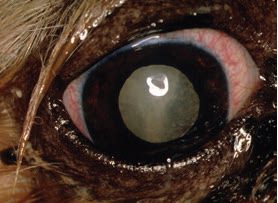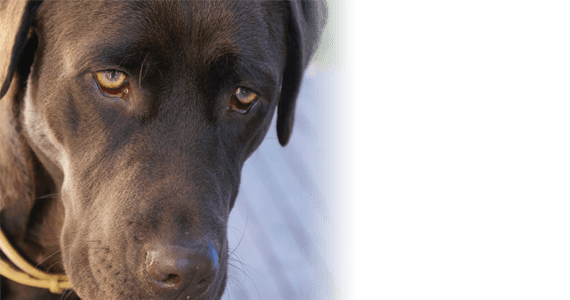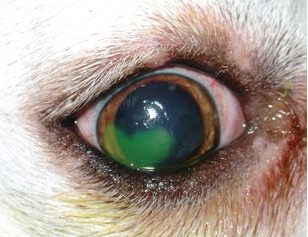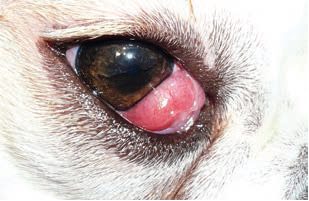Like horses, cats and dogs have relatively large eyes compared with people. In particular the cornea and lens are larger to give a wider field of vision. The many structures that make up an eye all need to be disease free and ‘in sync’ to have fully functioning vision and to be pain free.
by Rod Stephenson BVSc MVSc
PAC VETS for horses and all farm animals
www.pacvets.com.au
Normal eye characteristics
There should be good symmetry of both eyes to one another. The eyelids fit gently around the margins of the eye orbit with no, or relatively small area of white sclera visible. The iris is strongly pigmented and can be readily seen through a completely transparent cornea. The pupil allows light through the anterior chamber and then through the lens which is also completely
transparent. Light passes through the posterior chamber to the retina at the back of the globe which then sends signals along the optic nerve to the brain. An eye with good vision will have very active movement as the pet watches people, things and actions happening in its immediate environment. There will be various amounts of relatively small ‘weep’ accumulation in the
inside corner, especially after sleep, and after outdoor activity in particular during dusty weather.
Eye diseases in pets
The following information on disease issues mainly relates to dogs, and can be summarised into the following areas: –
- Outside the eye
- Inside the eye
- Inherited disease and anatomical abnormalities
Diseases of the outside of the eye
Conjunctivitis: The conjunctiva is a thin, pink, moist membrane over the white parts of the eyeball, and also the inside of the eyelids. It is usually transparent but becomes more prominent when it is inflamed. Conjunctivitis occurs when this membrane becomes irritated [clear discharge] or infected by a virus or bacteria [pus discharge] discharge from the inside corner of the eye. A whole range of reasons can be the cause. Breed issues such as dogs with loose or ill-fitting eyelids are prone to chronic or periodic ongoing conjunctivitis. Inturned eyelids can be a cause, an issue that ultimately requires some relatively simple corrective surgery. Other causes include allergies, injury to the eye [hit by a ball or other object, car incident], and foreign body such as grass seed, sun irritation, or chemical irritation.
Irritation can lead to bacterial and sometimes fungal infection. Treatment initially may just require mild decongestant drops or wipe with warm salty water. However if it persists, then seek veterinary advice, especially if only one eye is red. A foreign body is usually the issue and may also be in the deeper structures of the eye. Conjunctivitis due to infection be it viral, bacterial or fungal will require veterinary diagnosis and appropriate therapy. Always consider conjunctivitis as serious.
Ulcers of the cornea
A common and serious condition with some breeds more predisposed due to breed issues and / or age. Causes are varied, and can cause vision and potentially loss of the eye. The main sign is a red, sore, weepy eye which maybe slightly blue. Halfclosed eyelids may hide the ulcer, and the dog may wink one eye. Blue or cloudy cornea can be due to a number of causes. Oedema due to trauma will make the eye bluish. Glaucoma can cause cloudiness. Infection in the middle of the relatively thin cornea will also make it cloudy. There are in fact 4 layers that makeup the transparent cornea and any damage will reduce this transparency. Fine blood vessels and nerves make the cornea very sensitive and are also the basis for the healing process after trauma or infection.
Other conditions of the outside
‘Cherry eye’ occurs when a gland at the base of the third eyelid pops and bulges outwards and is seen as a discrete reddish tissue at the inside corner.
It can sometimes be manually replaced or reduced, or careful surgery may be necessary.
‘Dry eye’ is a condition where insufficient tears cause damage / infection with the pus accumulating on the cornea is a very good diagnostic sign, and usually quite painful. Small breeds with prominent eyes seem to be more prone. Artificial tears and other therapy are necessary.
Nasal fold irritation in short nosed breeds are due to the hair on the fold of skin falls onto the cornea and irritates. Growths may include hairy skin-like tissue, reddish, raised lumps, or fleshy superficial keratitis. Some are readily treatable, others can only be controlled. There are many other issues relating to specific breeds, and some that are random such as small tumours on the eyelid margin, and rolled-in or rolled-out eyelids can occur – with some being of major consequence. Overflow of tears can occur when the tear duct that normally drains the eye is blocked, or it may be irritation causing excessive tears spilling over onto the face.
Always bring any concerns that you may have to the attention of your vet when coming in for routine check-ups such as vaccinations [in case the vet does not pick-up on an issue that might not be immediately obvious].
Diseases of the inside of the eye
Inflammation inside the eye if not noticed or treated will cause blindness and be very painful. The earlier the inflammation is detected the greater the chance of a successful outcome or at least reducing the damage. Trauma, foreign body, complications of an ulcerated cornea, cancer, and idiopathic [unknown] causes including allergies to virus or bacteria also make up a large percentage of cases. Signs include red, weepy eye, especially if only one eye is involved, and you should seek expert examination.
Blood in the eye is serious, so keep your pet as immobile as possible in a darkened room, with no exercise allowed, and seek veterinary examination.
Glaucoma which means increased intra-ocular pressure, while serious is relatively uncommon, and can be inherited, or be due to other pathology such as trauma, lens dislocation or cancer.
Both reasons for glaucoma will cause vision loss, and treatment is basically the same, and can end in surgery for eye removal.
Importantly, the remaining eye must be checked, and medication is usually recommended as an ongoing therapy to reduce the possible risk of developing at a later date. The eye suffering from glaucoma generally has a clear weep indicating pain, the cornea is slightly cloudy, and the pupil is larger in size than the other, and not responsive to light.

Diabetes can result in pearly white lens and complete loss of vision. Other causes in young animals can sometimes be reversed. Bluey-grey ‘age related’ colour of the lens is not strictly a cataract disease but is simply due to a hardening of the old lens – however it fits the description and hence called a cataract. If cataracts are occurring in a relatively young dog, it is worth checking the condition of the retina, and if ok, then lens removal can be a good option. Specialists can also replace the lens similar to the procedure for people. Most small dogs can manage very well in spite of dense cataracts.
Disease of the retina affects the light and colour messages that can be passed onto the brain that interprets and integrates them as visual images.
The most common and serious is ‘Progressive Retinal Atrophy’ where the retina wastes and thins resulting in blindness. It is an inherited disease. There are many breeds that have this disease [as well as other retinal issues], and breeders should be vigilant in testing of both stud [parents] and all offspring. So be aware when purchasing pure breed pups, ask the breeder and also your veterinarian so that you are well informed.
Another disease ‘Retinal Atrophy’ is due to inflammation albeit due to a range of causes, and usually can be managed and controlled.
Inherited disease and anatomical abnormalities
Colour of the eye is inherited and dark brown is ideally best. Light coloured eyes do not tolerate bright sunlight as well as dark eyes. Dark pigmented eyelids are more resistant to sunburn and
cancer.
Blindness can occur with breeding dogs when both eyes have reduced pigment. Blind dogs can cope especially if it is of slow onset and the dog remains in familiar surroundings. Various, often small, changes in the way your dog interacts with surroundings, will give you the ‘heads up’, such as high stepping hesitant walk, reluctance to go outside at night, or erratic actions of performances dogs. If you find two very large pupils it will suggest total loss of sight in both eyes. Normally, if you shine a torch into the eyes the pupils will contract to shut out excessive light. Puppies will normally follow your hand whereas the pup with poor vision will not. There are quite a few strategies available to help a blind dog to cope.
Short nosed breeds essentially have the whole eye orbit outside of any bony support of the skull. Secondly, the bulging eyeball tends to have a weak blink reflex which results in poorer spread of the tear film. If an eye does pop out, keep the eyeball constantly wet and proceed immediately to your vet. If no vet is available, pull the eyelids out and over the eyeball, without undue pushing of the eye back in, and find veterinary help.
Breed
All breeds of pets have particular attributes that are attractive to prospective owners. Be informed of any potential inherited defects and diseases.
Many of these can now be tested either physically or by DNA examination of a gene marker.
Secondly, eye specialist clinics have the latest skills and technologies that can objectively diagnose most diseases and effectively treat and / or manage complicated eye issues.
Eye care by the owner
Proper home care sometimes over extended periods of months is essential for resolution of serious eye disease. Treating the eye is much easier if the patient is positioned properly.
Have an assistant [your neighbour if necessary] and teach your dog to sit still. Smaller dogs are best on a table, and large dogs backed into a corner – as compliance is critical and every step must be used to make it effective and stress free as possible. Do not allow the tube or dropper bottle to touch the eye. Always approach from behind the eye. Ask your vet or vet nurse for the finer points if your dog is resisting. When copious pus is present the upper and lower lids may stick together, liberally wet a cottonwool pad with warm water and hold firmly over the eye.
Take time and your pets will soon settle.
In summary, always seek assistance if you have any concerns, you will then have relative peace of mind and your pet will have every chance of enjoying good vision.



